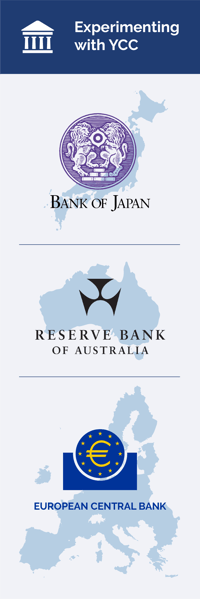We have witnessed central banks implement, reduce and exit quantitative easing (QE) programs to influence interest rates. Yield curve control (YCC) is another tool directed at interest rates. However, this policy stands in stark relief to QE. While central banks have implemented and tweaked YCC, they have not attempted to exit the policy. Until we see the implications of exiting the policy, it is still an experiment in real time.
What we know about YCC:
- YCC policies target a given yield through a mix of central bank communications and asset purchases.
- Because YCC typically results in fewer bond purchases relative to a quantitative easing program, we believe YCC has the potential to be more balance-sheet efficient.
- The Reserve Bank of Australia and the Bank of Japan have adopted formal YCC policies.
- While the European Central Bank has not implemented a broad YCC policy, it is using aspects of the tool as it targets financial conditions.
- We believe the Bank of England, unsettled by the size of its balance sheet size, could be weighing the potential of a YCC policy.
- There is no evidence that the Bank of Canada or the Federal Reserve are close to using a YCC policy.
What we don’t know:
- No central bank has exited a YCC policy. Therefore, we believe the implications are significant unknowns.
- While YCC is not a new tool, its prior use (like when the Fed set yield caps after WWII) provides little direction for how it can be used in today’s complex global markets.
- How would YCC work in developing countries?
Why use it?
Some central banks see YCC as a compelling tool. It can work in conjunction with negative rates, forward guidance and traditional QE. Or it can replace these options. YCC can focus on the long end of the curve or the short end.
For more on how central banks have been using yield curve control, read our new white paper:

WRITTEN BY:
Jon Levy, Senior Sovereign Analyst
Darcie Sunnerberg, Associate Director of Macro Strategies
Kaimin Khaw, Sovereign Analyst
Jingzhou Meng, Sovereign Analyst
MALR027106
Market conditions are extremely fluid and change frequently.
This blog post is provided for informational purposes only and should not be construed as investment advice. Any opinions or forecasts contained herein reflect the
subjective judgments and assumptions of the authors only and do not necessarily reflect the views of Loomis, Sayles & Company, L.P. Information, including
that obtained from outside sources, is believed to be correct, but Loomis Sayles cannot guarantee its accuracy. This material cannot be copied, reproduced or
redistributed without authorization. This information is subject to change at any time without notice.





